. .
MONDAY
SEPTEMBER 30 - 2019
Nore
Barn
The time is
fast approaching for the hoped for arrival of the
famous Spotted Redshank in the Nore Barn stream. If it
does come this will be its 16th year running which
must be a record! Last year our first sighting of the
Spotted Redshank was 29 Oct which is very late as it
is usually here by early October and sometimes even in
late September.
For details of past arrival and departure times of the
Spotted Redshank see . . . Spotted
Redshanks at Nore Barn
These thoughts
prompted my visit to Nore Barn this morning at about
11.30 with the tide rising rapidly. There was no
Spotted Redshank, but I was pleased to see
colour-ringed Greenshank G+GL - 'waiting' for
the arrival of the Spotted Redshank, its regular
feeding companion in the stream. Today, the Greenshank
was preparing to see out high tide on the edge of the
saltmarshes to the west of the stream. Greenshank G+GL
was ringed on 22-Sep-2014 and always arrives at the
Nore Barn stream a couple of weeks or so before the
Spotted Redshank.

Slipper
Millpond
I had a quick
walk round Slipper Millpond which was very pleasant,
but with nothing of special interest. However, I did
take note of three large birds, one on each of the
floating rafts. Grey Heron on the south raft, a
Herring Gull on the centre raft and a Little Egret on
the north raft.
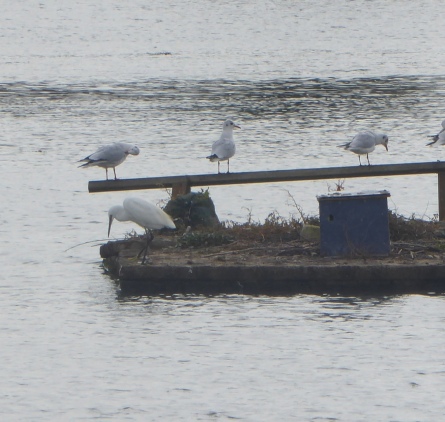
Langstone
Mill Pond
Peter
Milinets-Raby had a quick hour long look at Langstone
Mill Pond this morning from 10:38am. The tide was
pushing in quickly to high. On the last bits of mud
were 7 Sandwich Terns, a single Teal, 70+ Redshank
(one with colour rings -//B +B//RB), 2 Greenshank and
a first winter Mediterranean Gull. A Kingfisher was
darting about from boat to boat and occasionally
hovering over the slow moving tidal waters. Probably
the same bird was seen later dashing across the
pond.
On the pond were 14 Little Egrets, 11 Teal; a male
Shoveler coming out of eclipse plumage, 2 calling
Chiffchaff and 3 Tufted Duck (looked like a female and
two juvs) .
In the flooded horse paddock (just goes to show how
much rain we have had ) were 218+ Black Headed Gulls,
along with 15 Magpies, 2 male Pheasant, Jay, 8 Teal
and 2 Little Egrets.
Some southerly migration movement was noted today with
22+ Meadow Pipits, 38+ Swallows and a single House
Martin flying over. Also noted was a single Lapwing
flying west. In the distance off Conigar Point were 2
Shelduck and the head of a Seal popped above the water
for ten seconds.
Brent
Geese
Christopher
Evans walked round Farlington Marshes this afternoon
and had our first local sighting of Brent Geese this
winter. Off shore, at the southern end, there were
about 20 Brents in 3 small groups and a group of
probably 50 -60 were seen flying near one of the
islands. Best photo of the day was this
Kestrel.

SUNDAY
SEPTEMBER 29 - 2019
Arrival
of winter thrushes
Ralph Hollins
(now living in Scotland) writes to say he hopes we can
all share his excitement about the reports of the
first Fieldfares to be seen in southern England and
what seems to be the first report of a Redwing in
Holland.
He reports that the first Fieldfare of the winter were
a flock of 12 reported on Sep 23 in Bramshaw Wood on
the HOS sightings with the first Sussex report being
of 4 birds in the Salehurst area of the Weald on Sep
27 followed by 6 birds seen in Staffordshire on Sep
28. Surprisingly the only report of Redwing that he
has seen is of just 1 bird in Holland on Sep
27.
I would be grateful to
hear of any local sightings of winter thrushes. I know
we always used to see Fieldfare in the orchards at
Nutbourne, but I am not sure if they come now, though
the orchards are still there. Here's a nice photo I
got of Fieldfare feeding on Crab Apples in a Lumley
Road garden in the winter of 2010 - sadly the tree was
axed some time ago.

As for Redwings they
could pop up anywhere provided the weather is cold
enough to push them down south. Here's a nice shot
from Peter Milinets-Raby of a Redwing he captured at
Warblington last year.

Farlington
Marshes
Neill Foster
reported on yesterday's walk by the Friends of
Wildlife . . .
A
group of nine met on a bright but very blustery
morning. There was a warm welcome for Jean, a new
member. Derek was taking the photo.
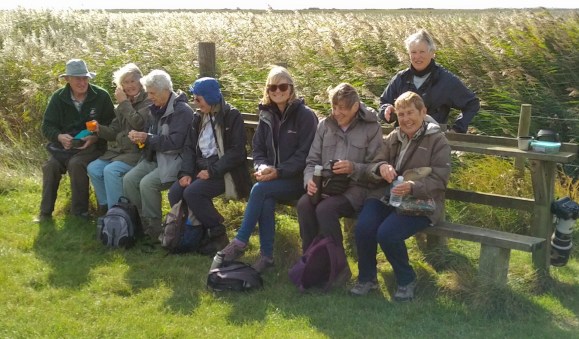
The
tide was low and rising. From the car park we could
see greenshank, redshank and ringed plover feeding.
Because of the strong wind it was decided to walk
clockwise around the marshes for an early check on the
bushes.
But first we had a preliminary look at the Lake. On
the far side, beyond an impressive area of red
glasswort, were good numbers of wigeon, redshank,
greenshank and black-tailed godwit. In smaller numbers
were dunlin, coot, and mallard. There was a brief view
of a wheatear flying off and a brief call of bearded
tit from the reeds.
Along the reed bed path, sheltered from the wind, we
found greenfinch, robin, blue tit, at least two
spotted flycatchers, and some linnets flying over.

On the
water were a pintail, Canada geese, mute swans, and a
shelduck. Huddled together was also a substantial
flock of black-tailed godwits; they suddenly took
flight but we could not find any approaching
raptor.
Near the information hut and beyond we found teal,
moorhens, stonechats and whinchats and then had a
brief view of a peregrine flying away from us. Also
present on the marsh were grey herons, little egrets
and, over the cattle, large aerobatic flocks of
starlings.
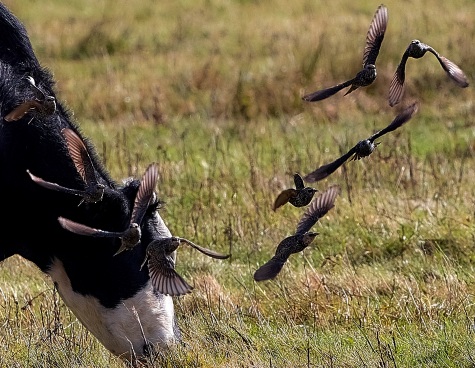
The
peregrine returned and flew over us across the sea
wall. A sandwich tern flew past and some reed buntings
were moving around in the bushes.

As we
approached the Point the tide was high and we could
see a flock of small waders looking for somewhere to
settle. When they landed, in a long row on top of the
sea wall, we could identify them: mostly ringed plover
with just a couple of dunlin.

On the
landward side were numerous meadow pipits feeding on
the ground, a couple of skylarks (not ascending much
at all in the wind!) and a single swallow.

A
Large White here was the only butterfly of the day. On
our return along the sea wall a curlew flew past but
there was little else to be seen as the wind had
become even stronger. Back at the Lake, even larger
numbers of mixed waders and ducks were huddled so
tightly packed with heads under wings it made
identification of any further species virtually
impossible.
Wild plants of note (with thanks to Rosalind for
listing them for us) were fennel, fleabane, perennial
sow-thistle, bristly ox-tongue, ragwort, mayweed,
creeping thistle, red clover, yarrow, mouse-ear,
tufted vetch, rock samphire, glasswort, dandelion and
teasel.
Thanks to all who came along, making it a most
pleasant morning out. And, as always, thanks to Derek
for the photos.
For more details of
this local wildlife group go to . . . Havant
Wildlife Group
WEDNESDAY
SEPTEMBER 25 - 2019
Mystery
tracks
Jennifer Rye
sent this interesting photo of a pattern of tracks
that appeared on a glass-topped table in her garden.
She wonders what creature made them.

In my view they are
almost certainly not the tracks of a bird as they
would show the typical bird foot pattern of one toe
back and three forward. My guess is they are of mice
or more likely young rats. One can see the imprints of
5 toes which will be of the hind feet which rats
usually use to get around. Their front paws have four
toes though these are often not visible in tracks. The
imprints clearly show the fleshy ball of the toes with
sharp claws. Any other opinions welcome!
MONDAY
SEPTEMBER 23 - 2019
Emsworth
Harbour
Peter
Milinets-Raby spent an hour watching the tide slowly
drop from Beacon Square from 9am. There were 99
Redshank (loads of colour ringed birds -//G +G//YG
& -//B + B//YG & -//G + G//YY & -//O +
O//NO & -//G + G//NB & -//G +G//WB)7
Greenshanks (only two out of the 7 had colour rings
G//R + LG//- & G//R + GB//- ). 1 Black tailed
Godwit, 31 Swallows heading east ahead of a strong
chilly wind and storm clouds.
Emsworth Harbour - 7 Turnstone, 30+ more Swallows, 1
Greenshank, 1 Grey Heron, 1 Sandwich Tern, 1 Osprey
over Thorney Island to start, then if was chased off
by 3 Carrion Crows out over Emsworth Harbour where it
circled around high for five minutes before slowly
drifting towards north Hayling.
The house by the Beacon Square footpath (one of my
dream houses with the perfect birding garden) has alas
been demolished to make way for a better house several
feet closer to the harbour (so the foreman told me).
It WAS a lovely house!!! More money than sense!!! I
hope the new one will be even better with viewing
platforms for the garden and the harbour, then I might
purchase it!!!
SUNDAY
SEPTEMBER 22 - 2019
Langstone
sightings
Christopher
Evans has seen 3 Kingfishers in the local area over
the past week, a good sign that they are now moving
down to the coast from their breeding grounds inland.
Interestingly, he found about 40 Little Egrets perched
trees at the back of the Budds Farm lagoon. He thinks
this maybe an overspill site from the large colony at
Langstone Mill Pond.
Christopher also came across a Grey Wagtail on the
upper reaches of the Langbrook Stream in the A27
underpass just south of Tesco. He got some nice photos
despite the poor lighting. It looks like a juvenile
with white throat and soft expression.

I have also seen Grey
Wagtail in similar situations. They are sometimes seen
in the railway tunnel that carries the River Ems into
Brook Meadow.
Walderton
Steph Dale
reported on yesterday's walk by the Friends of
Wildlife group.
A
happy relaxed group of 6 met on a warm, bright and
sunny morning at Walderton.
We
headed to Cooks Lane and then northwards to Watergate
Park. We crossed the Walderton-West Marden road and
walked south along the bottom of Watergate Hanger. At
the top of Brocks Knapp we walked about half a mile
along the top of the hanger and then retraced our
steps and headed back to Walderton.
We saw swallows early on and later saw more swallows
(about 60) and some martins. Throughout a large part
of the walk we were aware of buzzards overhead as they
were calling loudly.
We came across a dead slow worm still partly hidden in
a hole in the ground and Neill spotted a damselfly
sunbathing on a fence post.
The ivy was in flower and on the flowers were many ivy
bees (first identified in the UK in 2001). Very
surprisingly we came across some cow parsley in
flower. We also identified groundsel, marjoram,
nettle-leaved bellflower, yarrow, cudweed, fleabane,
ragwort, hedge woundwort, scentless mayweed, dark
mullein, black nightshade, redshank, field bindweed,
common toadflax, spear thistle and creeping thistle.
We noted a few spurge laurel plants and the butchers
broom was bearing berries.
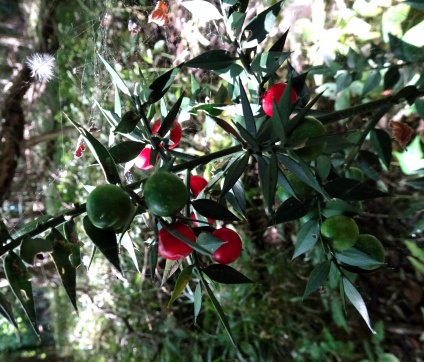
Butterflies
included small white, meadow brown and red
admiral.
We listened to a hidden bird tapping in a tree for
quite some while. When it flew away we decided it was
almost certainly a nuthatch.
Although we enjoyed the walk, sunshine and company we
were a little disappointed that we didn't see more
birds.
SATURDAY
SEPTEMBER 21 - 2019
Brook
Meadow
I was pleased
to have the company of Dan Mortimer for this
afternoon's stroll through Brook Meadow. We had a look
at the hedgerow at the far end of the Seagull Lane
patch which has a fine mixture of fruit and other
bushes. We agree with Maurice Lillie that it would be
a pity to disturb such a rich and fruitful hedge by
laying it to bring it into line with the rest of the
hedge which has already been laid. All it needs it
some careful pruning, thinning and height control. Dan
had a taste of one of the abundant crop of small
apples, but they are not yet ripe. Are they Crab, we
wondered?

We had a nice chat
with a lady reading the signcase displays. She was
very appreciative of the work of the group and thought
the meadow was simply wonderful! Hear hear!
We had a look at the great crop of berries on the
Gwynne Johnson Rowan plantation on the east side of
the north meadow. We thought the berries were best
left to the birds as they were difficult to process
and bitter to the taste.
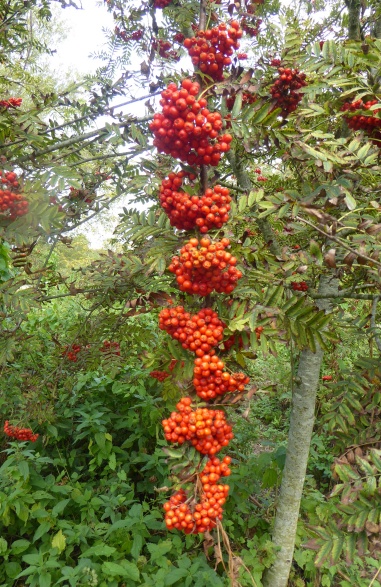
We had a look at the
ailing Black Poplar which has lost most of its
foliage. The leaves are all badly affected, but there
are fresh buds on the twigs which is a promising sign
for the overall health of the tree. The thin brown bud
is between the two leaves.

Finally, we had an
excellent sighting of a Painted Lady feeding on
the bank of Common Fleabane on the edge of the Lumley
copse. This is a great spot for insects.

While we were watching
the Painted Lady, a magnificent Hornet flew
around the flowers for a couple of minutes, but never
stopped once for a photo! So here is one that I did
get a couple of years ago resting on the ground.

After Dan left for
home I returned to the Lumley copse and found the
Painted Lady still present but accompanied by a
Small Copper. Here's a shot I got of both
butterflies feeding on the same Common Fleabane flower
- a first for me!

Hummingbird
Hawkmoths
Ian Mears
sends a couple of cracking photos of Hummingbird
Hawkmoths, one feeding and one at rest. He says a pair
has been almost resident in his garden for the last
month or so. Lucky chap.
Ian also reports that
yesterday evening there were 12 Yellow Wagtails
amongst the cattle on Northney Common!!
Kingfisher
Jo Bray was
lucky enough to see a Kingfisher the other morning
flying across Peter Pond, and another one along the
Ems at River St, Westbourne! The river there is really
dry at the moment! Jo says, "Two in a week is a
record...usually I don't see any for years!!"
Thanks Jo. Yes, the birds are starting to move back to
the coast after the breeding season. They will be far
more common sight in the winter months.
Here's a cracking shot of a female in flight that
Malcolm Phillips captured over Peter Pond.

FRIDAY
SEPTEMBER 20 - 2019
Warblington
shore
Peter
Milinets-Raby had a 105 minute wander around the
Warblington shore this morning from 9am - the tide was
out and very low. There was very little to be seen so
he concentrated on the hedges for migrants. Slim
pickings in the brisk chilly wind, but some nice
individuals. Peter's report . . .
The Warblington cemetery held 2 Chiffchaff (one
briefly singing) and a singing Coal Tit (great views).
The SSSI field had 3 Meadow Pipits, a brief, BUT
extremely obliging Wheatear perched on the sea wall.

The end of the main
hedge held an amazing 10 female and 5 male Blackcap
along with 2 striking Lesser Whitethroats and a
fly-catching Spotted Flycatcher, which alas soon moved
on. In the Tamarisk hedge were at least 3+ Chiffchaff,
along with 1 Linnet.
A Sparrowhawk dashed through the charm of 20+
Goldfinch, but appeared to miss!
At the end of the Pook Lane hedge was a handsome male
Stonechat.
On the low tide mud off Pook Lane were 4 Grey Plover
and a single Greenshank and off Conigar Point were 9
eclipse plumaged Teal and 2 Dunlin. Not many waders
around.
Wheatear
correction
Ian Mears
writes to say that his photo in yesterday's blog which
I labelled as Wheatear was in fact a juvenile
Redstart. Sorry about that, I just did not notice the
red tail. This indicates the importance of labelling a
photos for inclusion in the blog as I could (and do)
get them wrong! See Peter's Wheatear above for useful
comparison.

Caterpillar
attacks snail
Barry
King-Smith sent me an interesting photo of a
caterpillar appearing to attack a snail near his home
at Nore Barn, Emsworth. Barry said the snail was on an
open terrace and not heading for cover. He removed the
caterpillar which immediately climbed back onto the
snail.

I had a quick look on
the internet and discovered to my great surprise that
some caterpillars do eat snails! I found a fascinating
YouTube video of a caterpillar seemingly attacking a
snail similar to what Barry saw, though this video was
taken in Nigeria! Personally, I have never come across
this before. Does anyone have any knowledge of this
unusual behaviour?
YouTube video of
Caterpillar attacking a snail. Skip the advert at the
start of the video . . https://youtu.be/e06m16HVQoA
THURSDAY
SEPTEMBER 19 - 2019
Brook
Meadow Workday
There was a
good turn out of volunteers for this morning's work
session on a perfect autumnal day led by Reg Newnham.

The main task was to
reinforce the north path using logs from the tree
cutting. This was heavy work, but all the volunteers
got stuck in to create a nice extra habitat for
beetles and other creatures as well as strengthening
the path.

More the full workday
report and more photos please go to . . .
https://www.brookmeadow.org.uk/conservation-news/
Black
Poplars
I had another
close look at the two Black Poplars on the Lumley
area, the right side one of which has lost most of its
leaves.

Looking more closely,
I discovered the leaves on the apparently ailing tree
appeared to have been attacked by a leaf mining insect
producing dark blotches between the veins and around
the edges of the leaves. The other tree with its
leaves still intact appeared to be unaffected apart
from a lot of very small spots on the leaves.

A quick search of the
internet indicated that all Poplars, including Black
Poplars, are attacked by a number of different leaf
and stem mines of flies and other insects. Mining
Diptera larvae are leg-less maggots which feed inside
the leaf leaving characteristic patterns on the leaf,
similar to what we have on our Black Poplar. As far as
I can establish the attacks do not seriously affect
the health of the tree. However, I would really
appreciate more information on this from anyone more
familiar with trees and their problems than me.
Dragonfly
While we were
looking at the Black Poplars, Colin and I spotted a
fast flying dragonfly which I tentatively identified
as a Southern Hawker. These handsome insects
are fairly common on the meadow at this time of the
year. They have a characteristic behaviour of coming
quite close to you, almost 'buzzing' you. Fortunately,
this splendid fellow settled down on some vegetation
allowing me to confirm the identification and get a
photo.

Eastern
Olivaceous Warbler
Peter
Milinets-Raby received some photos today of the
Eastern Olivaceous Warbler which has created
considerable excitement at Farlington Marshes. He says
the photos were sent by an anonymous admirer, who
loves reading my blog daily. That's nice! Peter adds
that the two photos show extent of downwards wing
flicking which apparently is characteristic separating
this bird from the common Reed Warbler.
According to my book
Olivaceous Warbler winters South of the Sahara and
summers in the Mediterranean region. It is very rare
in this country but was seen in June this year on Fair
Isle Scotland. There are some cracking videos of the
bird on YouTube.
Autumn
Talks
Ian Mears
sends me the autumn series of talks of the Emsworth
& Hayling Wildlife Trust at Warblington School
starting at 7.30pm. They look really interesting.
25th September- Birds of the World by local naturalist
and photographer Alan Key
23rd October- The Knepp Rewilding Project by Estate
Ecologist Penny Green
27th November- Hampshire's Chalkstreams by Dr Ben
Rushbrook, Senior Ecologist of the Trust.
Northney
Almost as an
afterthought Ian sends me some cracking photos taken
at Northney over the last few weeks. The encounter
between a Sparrowhawk and a Starling must be the most
dramatic photo ever on my blog - I have suggested to
Ian he enters it in a wildlife photo competition. It
is brilliant!

Less dramatic, but
equally good are Ian's photos of a juvenile Spotted
Flycatcher and a juvenile Redstart.
WEDNESDAY
SEPTEMBER 18 - 2019
Afternoon
walk
After lunch I
walked though Brook Meadow down to Peter Pond. While
on the meadow, I used my camera to capture pictures of
Honey Bees feeding on the Common Fleabane
flowers. How do they managed to haul around those huge
sacs full of pollen?

I had a mooch around
in the Lumley copse where there are many fallen
Crack Willow trees. Here's a rather dramatic
one that took my fancy near the Lumley Stream.

I happened to meet my
friend and neighbour John Tweddle on the meadow
walking his dogs. I introduced him to the new path
around the back of the Gwynne Johnson Rowan
plantation. We noted a Hedgehog seemingly
squashed on the new path, presumably inadvertently
done by the conservation cutting team. Hedgehogs are
very rare on the meadow. John said he'd recently seen
a dead one in Bridge Road, hopefully not one of those
that regularly come into my garden.
I pointed out to John an unusually tall Guernsey
Fleabane behind the Rowans, having pushed its way
through a jungle of brambles and bindweed. It was
taller than me! These unusual plants are now popping
up in several places on the meadow.

Down at Peter Pond I
watched two large dragonflies chasing over the
reedbeds to the west of the pond. Blue bodies and
green thorax suggests possible Emperor
Dragonflies? I tried to get a photo, but they
never stopped. Here are my best efforts in flight.
I stopped to chat to
three people on the Lumley footbridge who were
fascinated by the large Grey Mullet swimming in the
channel and pool. They introduced themselves to me and
said they have recently taken over one of the
workshops in Palmer's Road next to AD Williams and
were delighted to have the Brook Meadow nature reserve
so close which they have already walked through.
Finally, walking back
along North Street I spotted a notice pinned to the
door of the now closed Robsons Opticians to say
they would be re opening soon. Inquiries to Loat
Opticians of Hayling Island - who I assume are taking
over.
TUESDAY
SEPTEMBER 17 - 2019
Brook
Meadow
One of the two
Black Poplars (the right hand one) looks a little
unhealthy, having lost most of its leaves. The other
one is fine. I am not sure how significant this is,
but I shall keep an eye on it.

Here's a close up of
the right hand side one

Lumley
I stood for several minutes on the Lumley
footbridge watching the Grey Mullet swimming around in
the pool created by David Gattrell's mini weir.


I was surprised to see
the house named 'The Arches' near the railway is up
for sale not more than 2 years after its complete
refurbishment.
Westbourne
fields
I had a
nostalgic stroll through the fields behind Westbourne
Avenue where I and my growing family used to live.
Good to hear there will be no house building here.

I had a look over the
wall at the end of our old garden which holds such
vivid memories. There are some very nice Bramleys on
one tree. The Blackberries are very small this year.

Neko
graffiti art
The graffiti
art gallery is still looking good in the subway under
the A27.

Unusually for graffiti
the art work includes flowers and a rural scene with
cattle!
Is this a self
portrait?
The artist Neko leaves
us with a heart warming message 'Be Great Today'.
Thanks Neko, I will try!

Checking on the
internet, I was very surprised to find quite a lot
about Neko - a well known and well travelled graffiti
artist apparently. Maybe this display should go on the
Emsworth Arts Trail?
MONDAY
SEPTEMBER 16 - 2019
Brook
Meadow
Just before I
entered the meadow at the end of Seagull Lane this
morning I stopped to examine the Buddleja bush just
inside the gate which rarely has anything of special
interest. However, today I spotted the distinctive
shape and size of a Hornet Hoverfly
(Volucella zonaria) settled on one of the large
blossoms. This harmless insect gets its name from it
resemblance to a Hornet.

I had a quick look at
the river at the north bend where I disturbed a Grey
Heron fishing in the shallow water. I walked south
down the main river path from the north bridge,
looking for plants and insects on the way.

On the river bank just
south of the north bridge I noticed several plants of
what I assume are Guernsey Fleabane (Conyza
sumatrensis) However, I need to get a sample to
confirm its identification, but could not reach them.
The leaves should be edged with hooked hairs.

This rather unassuming
plant is a recent introduction from S America (1974)
and is spreading rapidly mainly in the South of
England on disturbed ground, particularly in urban
areas. It tends to pop up in car parks and along
pavements, but is fairly uncommon on Brook Meadow
which is why I mention it here.
The plants alongside
the main river path are always a good place to see
insects and today I discovered a good number of
Dock Leaf Bugs (Coreus marginatus) (50+)
mostly on Dock leaves. Here are a few of them on one
leaf.

Tern
raft on Thorney Deeps
In the current
Newsletter of the Sussex Ornithological Society, Pete
Hughes gives a fascinating account of the successful
installation of an artificial Tern nesting raft on
Thorney Great Deeps. The raft was built by Chichester
Harbour Conservancy rangers and volunteers. The
surface was covered with a shingle/sand mixture and a
mesh fence was attached to the outside to prevent
young chicks from falling out. Tern decoys were used
to attract the Terns to the rafts and wooden shelters
installed to help the young birds avoid predators or
periods of bad weather.
Most important, motion sensing cameras were fixed to
the rafts to record the breeding season's progress. As
Pete says, the camera provided "a complete soap opera
of activity with fights, squabbles, courtships and
sex, good and bad parenting, a lot of noise and a lot
of fish". The cameras also provided good information
about the food brought in by the Terns which included
a variety of fish and a few insects. Pete included the
following image of Terns flying taken by the raft
camera. That's great!

Overall, the raft was
a great success with seven pairs of Common Terns
nesting and producing 20 chicks. Hopefully some of the
chicks will return and breed around the harbour. Pete
plans to expand the provision of rafts in Thorney
Deeps and elsewhere around Chichester Harbour.
There are already two
well established nesting rafts in the lagoon at
Hayling Oysterbeds which have been well used by Common
Terns (though not by Little Terns). Here's a picture I
took of the Hayling rafts earlier this year.

SATURDAY
SEPTEMBER 14 - 2019
House
Martins on the move
Sue Thomas
reports huge numbers of House Martins ... at least 45
in one sighting, swirling and feeding over her house
in Westbourne and then moving south. This continued
for about half an hour at 8am. Sue recorded a similar
sighting 2 years ago in early and mid September.
Please keep a look out for migrating birds
particularly around the coastline. Last year we had a
flock of around 200 House Martins flying around and
perching on the wires and roof of the Emsworth Sailing
Club on Sep 24 and hundreds more around Nore Barn.
Here is a shot of some of them on the wires by the
sailing club I got last year.

Brent
Geese are also on the move
Ralph Hollins
reminds us to look out for early and numerous Brent
Geese (both Dark and Light-bellied). On Sept 13 the
Portland website reported ... 19 *Pale-bellied Brent
Geese* dropped in at Ferrybridge - part of what sounds
to be a notably large early arrival around the
southwest of England.
Also seen on the HOS reports for Sep 11 was one of 27
Light Bellied Brent at The Kench on Hayling and on Sep
12 22 Dark Bellied birds were new at Pennington while
on Sep 13 Tim Doran reported 16 Light Bellied in
Langstone Harbour (just 2 families with 7 and 5
juveniles).
Typically, the first Brent Geese (Dark-bellied) arrive
in Emsworth Harbour in early October. I always look
forward to their atmospheric croaking calls echoing
across the mudflats.

Pagham Harbour
Heather Mills
reported on this morning's walk by the Friends of
Wildlife group
A select group of five met today at RSPB Pagham
harbour on a glorious sunny morning.
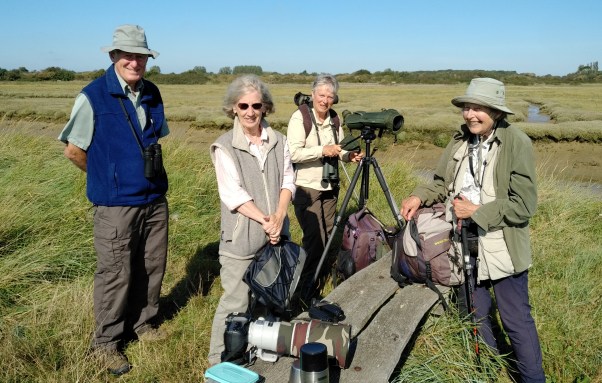
As I was early I
scouted ahead and had a Green Woodpecker with lots of
Goldfinch. A Spotted Flycatcher remained for the
others to see, when we ventured out to the new
hide.
A group of 29 Black-tailed Godwits lazed in the pool
near to the roadside. A lone Common Sandpiper dabbled
at the back whilst a plentiful supply of Swallows and
House martins hoovered up the wealth of insects as
they flew past. A flock of Teal dabbled in the pool
with some Black-headed gulls and Lapwing. Blue, Great
and Long-tailed tits flitted through the bushes with a
few probable Chiffchaffs, and Chaffinch, Greenfinch
and a good number of House Sparrows.. We ventured out
to the outfall area and along came a Kingfisher.
We retraced our steps back to the footpath and went on
our way towards Church Norton. A couple more Spotted
Flycatchers flew ahead so that we could identify them
and Derek got a picture of one with a fly.
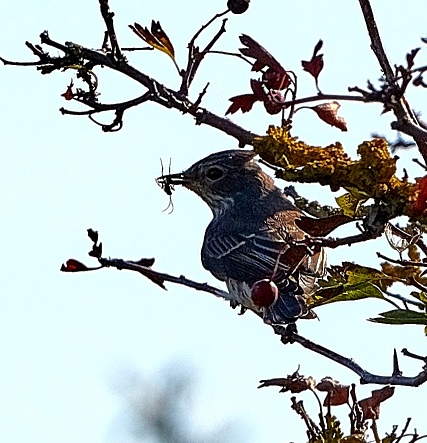
However, there were no
Reed Buntings at all heard or seen there and back.
Stock doves called and a few Pipits flew over. We
spent our coffee break overlooking one of the tidal
estuaries where a great many Curlew could be seen and
a few heard. Juvenile Shell Ducks and at least four
Avocets with Redshanks were seen in the distance. We
eventually proceeded along the footpath and Neill
spotted what turned out to be the bird of the day, a
Marsh Harrier. It was behaving rather strangely in
that it dabbled in the middle of the incoming tide.
Enjoying having a paddle it seemed!
Nearer to Church Norton we had good views in the
scopes of a couple of Ringed Plover with
Oystercatchers and a long line of Cormorants sitting
on a bank. Great Crested Grebes swam on the incoming
tide. Many Great Black-backed Gulls could be seen in
the distance. Other birds seen were a Buzzard and
Kestrel and we also had a Cetti's warbler practicing
it's song. A group of 4 Dunlin were seen as we
returned and had a final look at the ferry
pool.
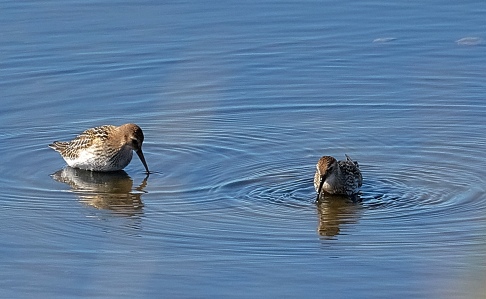
Plenty of plants still
about. Jill could smell the Sea Lavender which was
abundant along with Common Mallow, White Dead nettle,
Pink and Sea Campion on the shore, White Campion on
the reserve. Dark Mullein, Black Knapweed, Hoary
Ragwort, Thrift, Black Horehound, Creeping thistle.
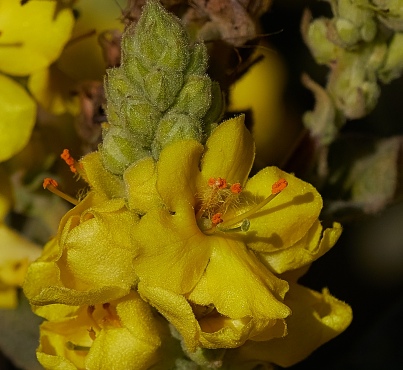
Butterflies seen, Red
Admirals, lots of Speckled Woods and plentiful Small
Whites. Small Copper, Silver y moth and a Painted
Lady. A very pleasant outing.
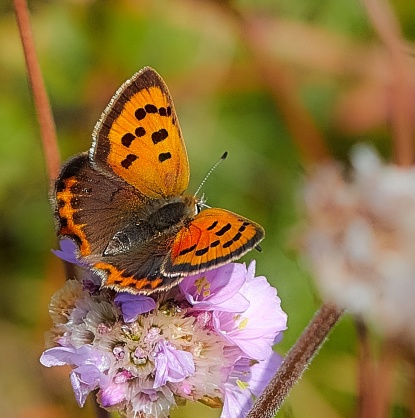
For more information
on this local wildlife group go to . . .
Havant
Wildlife Group
FRIDAY
SEPTEMBER 13 - 2019
Hummingbird
Hawkmoth
I have seen
one of these spectacular insects twice in the past
couple of days. One was on Portsdown Hill yesterday
and today I had another hovering over the Geranium
flowers in a pot outside our front door, rapidly
darting from one flower to another. I was not quick
enough with my camera to get a good shot, but this was
my best effort this morning. Has anyone got a better
picture?

This moth gets its
name from its similarity to the Hummingbird which it
is sometimes mistaken for, though Hummingbirds are
never seen in this country. Like the Hummingbird it
hovers in front of flowers inserting its long
proboscis into the cavity for nectar. It is an
immigrant from Southern Europe and North Africa each
spring and summer and is widespread in the UK, most
common in South and Midlands. It breeds here and
attempts to hibernate as an adult, but rarely survives
the winter in this country. Hence, it continuing
presence in this country is dependent on the annual
influx from the south. There is some evidence of a
return migration in the autumn.
Warblington
shore
Peter
Milinets-Raby spent a couple of hours visiting the
Warblington shore this morning from 9am - tide pushing
in to high. The highlights were as follows:
Off Pook Lane: 17 Knot, 2 Bar-tailed Godwit, 6
Black-tailed Godwit, 13 Dunlin, 5 Greenshank (G//R +
LO//-), 1 Shelduck, 1 Great Crested Grebe, 1 Hobby -
picked up by luck in the scope as it flew north across
the channel from Hayling, then headed straight up
along the side of the trees above the Pook Lane track,
then hunted along the hedges over Warblington before
heading east. Great views. 35+ Swallow seen, 2 Stock
Doves, 2 Wheatear - one on beach one on posts along
main path, 3 Buzzards soaring over Wade Lane.
SSSI field. Another Wheatear (see photo).

In end of hedge in
SSSI field were 3 male and 4 female Blackcap, along
with 2 Whitethroat and a Chiffchaff. 3 female Pheasant
also in the field
Off shore at Conigar Point: 3 Sandwich Tern, 6
juvenile Common Tern, 2 Buzzard distantly over Hayling
and Thorney Island, 2+ Meadow Pipits heading north.
THURSDAY
SEPTEMBER 12 - 2019
Fort
Widley
After an early
afternoon appointment at QA Hospital I drove onto
Portsdown Hill and did one of my favourite walks
around Fort Widley. The weather was cloudy, but
remarkably warm. First, I walked round the back of the
fort where I found masses of Old Man's Beard,
some of which I collected for my wild flower displays.

Most of the wild
flowers were over, but the hillside to the west of the
fort had a wonderful array of flowers.

They included Field
Scabious and several patches of Eyebrights.
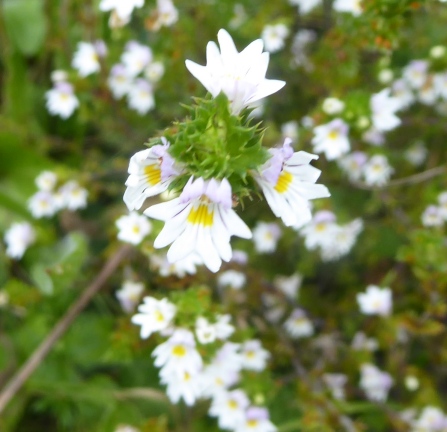
I always enjoy the
views across Portsmouth from the hill below the fort,
though the light was a bit murky today for good
photos. The large building in the foreground is QA
Hospital.

Walking along the path
below the fort I was struck by the huge spikes of
Weld. I measured this one as about one metre, though I
gather from Blamey, Fitter and Fitter they can get to
1.5m.

WEDNESDAY
SEPTEMBER 11 - 2019
Langstone
Mill Pond
Peter
Milinets-Raby visited Langstone Mill Pond this morning
for an hour from 9am - the tide was pushing in to high
and there was a spitty drizzle being blown about by
the wind!!
On the last patches of mud before the tide pushed in
were 6 Sandwich Terns (see photo taken on the phone
through the scope!), 14 Teal, 27 Black-tailed Godwit
and 5 Greenshank.

On the pond were 14
Teal, a single Kingfisher, a juvenile Tufted Duck, 1
Shoveler, 1 Grey Wagtail, the Mute Swan family, 28
loitering Little Egrets - the island chick still on
the nest, but nearly fledged and 2 Grey Herons.
And flying over the pond heading south were two flocks
of Sand Martins (5 in each).
In the distance off Conigar Point on the last blob of
mud were 21 Grey Plover, 3 Knot, 6 Dunlin, 2
Bar-tailed Godwit and 5 Shelduck,
TUESDAY
SEPTEMBER 10 - 2019
Brook
Meadow signcases
As previously
arranged, Dan Mortimer came round to my house at 11am
to collect the three signcase display boards which I
have spent the past few days updating with new photos.
This new arrangement in which Dan collects the old
display boards and delivers them to me at home for
updating is working very well. Today. Dan replaced the
damaged perspex window in the north gate signcase with
a new one. This makes a big difference and really
brings the displays to life. These windows do need
replacing every so often. Here is Dan at work cleaning
the north gate signcase.

Here is a shot of a
couple of visitors new to Brook Meadow reading the
newly installed displays.

While we were at the
south gate signcase I spotted a single plant of
Guernsey Fleabane just in front of the signcase. This
is the first Guernsey Fleabane of the year on
Brook Meadow, though they are fairly common around the
town. They tend to pop up in car parks and along
pavements.

Other
Brook Meadow news
I happened to
meet Jennifer Rye outside the Emsworth Co-op who told
me that Colin Brotherston had agreed to take over as
Chairman of the group. That will be a relief all round
as Jennifer has been obliged to give up the post due
to poor health. Roger Mills has agreed to take over
the production of the printed newsletters which had
been done by Colin for the past few years. Thanks for
that Colin.
Jennifer also told me
that the AGM of the Brook Meadow Conservation Group
will be held in St James Church Hall on Friday 8th
November at 7pm. It is hoped that Sarah Hughes, the
Sussex Community conservation officer who has helped
us a lot in Water Vole surveys, will be able to do a
talk.
Jennifer also told me
the good news that a small group of children from
Emsworth Primary School will be visiting Brook Meadow
on Wed 18th September to learn about the River Ems and
its wildlife.
SUNDAY
SEPTEMBER 8 - 2019
Gnawed
Willow logs
I received
replies to my query about the mysterious gnawed Willow
logs on Brook Meadow that I reported in yesterday's
blog. Maurice Lillie and Colin Brotherston both report
having seen a dog stripping the bark from the Willow
branches during the last work session, probably the
same dog with a taste for the sap in all these cases.

Gilbert Wheelwright
added that the ingredient in Willow bark is Salicin
which is produced by the bark and from which it gets
its name - the scientific name for the Willow is
Salix. Gilbert says it can be used as an alternative
to Aspirin, which is actually created by chemical
reaction between acetic acid and salicylic acid (the
precursor to Aspirin and derived from Salicin).
But does anyone know why is Salicin so attractive to
dogs, assuming that there was more than one dog
involved in the damage?
Autumn
Butterflies
Large and
Small White butterflies are certainly the most common
ones flying at present. I regularly get 6 or more
feeding on the Perennial Verbena in my garden which
also attract the occasional Red Admiral and Painted
Lady. David Minns has also had two Red Admirals and a
Painted Lady on his Buddleia, both of which are fairly
common autumn butterflies. Another typical autumn
butterfly is Clouded Yellow but I have not seen one as
yet. Has anyone else?
Here is a Clouded
Yellow taken in Brook Meadow a couple of years ago

Warblington
shore
This morning
Peter Milinets-Raby had a wander along the Warblington
shore as the tide fell from 10:45am for 2 hours. The
highlights were as follows:
Main hedge by the cemetery: 1 Sedge Warbler, 1 Yellow
Wagtail over, 1 Sparrowhawk and 1 Kestrel, 5 Meadow
Pipit over north, 6 to 17 Swallows over.
Off Pook Lane: 33 Black tailed Godwit, 3 Greenshank
(G//R + LO//-), 12 Knot, 8 Grey Plover, 2 Great
Crested Grebes, 5 House Martin, 3 Ringed Plover, 1
Bar-tailed Godwit.
Conigar Point: Linnet heard, Tree Pipit heard
only as it headed south (only my second ever record),
1 Wheatear in the SSSI Field, 51 Knot ( nice tight
feeding flock), 2 Curlew Sandpiper - feeding in the
muddy gullies. 8 Ringed Plover, 4 Dunlin, 1
Greenshank, 1 Med Gull, 2 Meadow Pipit over.
Tamarisk hedge; 3 Chiffchaff (plus one other singing),
1 Willow Warbler.
Quite a good selection of migrant birds.
Stansted
Forest
The Friends of
Wildlife group had their Saturday morning walk in the
grounds of Stansted estate. Valerie Mitchell provided
the following report and Heather Mills the photos.
A
group of 9 met on a pleasant autumnal morning at
Stansted House Garden Centre car park.
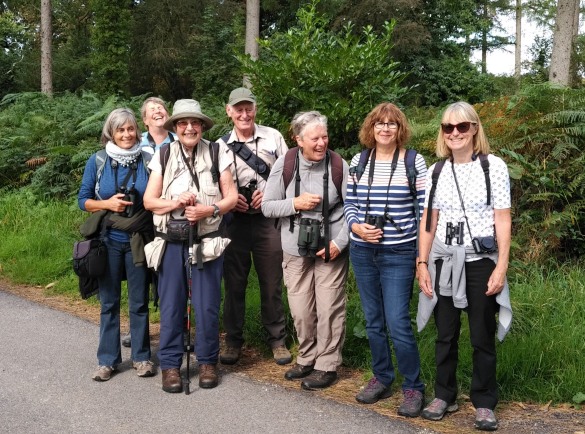
Walking
along the bridleway in front of Stansted House we saw
house martins and swallows flying around in front of
trees at the far side of the meadow, also stock dove,
jackdaws, chaffinch and pied wagtail. In the hedgerow
we saw 2 perfect spiders' webs complete with garden
spider on each.
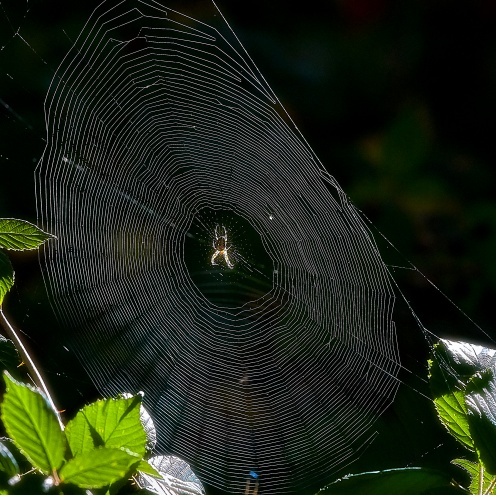
Green
and great spotted woodpeckers flew among the trees.
Later on we saw a young great spotted woodpecker being
fed. We continued up Rosamund's Hill and in a sunny
clearing we saw a beautiful female Goldcrest,
she moved around, but stayed in view for a long time,
her yellow crest shining in the sun (the male
Goldcrest has an orange crest). A spotted
flycatcher also flitted about.
On
turning around we spotted a brown hare, haring across
the field.
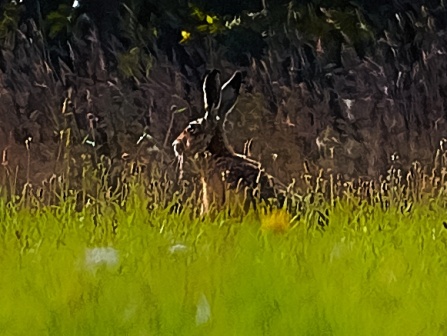
After
turning right onto the footpath we saw wren,
yellowhammer, flock of goldfinches, chiffchaff,
blackcap and heard a nuthatch. Buzzard was flying, and
one seen resting in a tree. A blue hawker was spotted.
Butterflies included large and small white, comma, red
admiral.
We saw
lots of wild flowers which were generally past their
best, but lovely to see. Also plenty of black, elder,
hawthorn and spindle berries, sweet chestnut, hazel
nuts, ivy flowers, rose hips and crab apples, plenty
of food for autumn and winter.
A
very bright patch of yellow Stagshorn Fungus was
spotted beside the road as we returned after an
enjoyable walk.

For more details of
this local wildlife group go to . . . http://familyfellows.com/hwg-index.htm
SATURDAY
SEPTEMBER 7 - 2019
Brook
Meadow
I had a walk
through the meadow this morning, mainly looking for
interesting items for the autumn update of the Brook
Meadow signcases. I took plenty of photos of autumn
flowers, such as Common Fleabane, Hoary Ragwort, Wild
Angelica, Hedge Bindweed, Bristly Ox-tongue and Water
Mint, all of which are abundant on the meadow. Many
flowers have bees collecting pollen - I caught a bee
entering a white Bindweed trumpet flower. I wonder
what it is like in there?
I also looked at tree
items, such as bronzed Crack Willow leaves, Oak
acorns, Hawthorn haws and Apples.
The Rowan berries are
simply stunning this year. Maybe Gwynne Johnson is
looking?

Gnawed
Willow logs
During my
walk, I stopped to examine the felled Crack Willow
branches that the group had recently laid beside the
north path. The bark of two of the branches had been
stripped and the underlying flesh gnawed with teeth
marks clearly showing. One of the Willow logs outside
the HQ Tool Store has been similarly gnawed.

Close-up of gnaw
marks

I have not seen this
before on the meadow. I am aware that deer and horses
do occasionally nibble at trees, but it seems unlikely
that they were responsible for this damage. I
mentioned this to a passing dog walker who told me
that dogs also are partial to nibbling on trees which
seems a more likely explanation. A quick search of the
internet confirmed this as fact, though there were
concerns expressed that the tree flesh could be toxic.
I gather that the bark of Willows contains salic acid
which is a pain reliever and the basis of asprin. I
did have a brief nibble myself of the flesh under the
bark which tasted slightly sweet. I would appreciate
further information from others who have more
knowledge of dogs than I do.
FRIDAY
SEPTEMBER 6 - 2019
White-tailed
Eagle returns home
Roy Dennis
(Wildlife Foundation) reported in his blog last night
that the White-tailed Eagle named Culver, after an
extraordinary eight day 680 km flight around southern
England as far as Essex, was back 'home' on the Isle
of Wight. What's more, he made landfall over Culver
Cliff - the site of the last known breeding
White-tailed Eagles in southern England in 1780 and
the place the bird is named after.
Here is a map
showing Culver's jaunt (in red) around the
mainland

Here is a map showing
Culver's arrival on the Isle of Wight

It will be fascinating
to see what Culver does next. Will he remain on the
Isle of Wight, like the other five young eagles, or go
wandering again? Keep up to date with Rob's blog . . .
http://www.roydennis.org/category/sea-eagle/culver/
While on Thorney
Island Culver was seen and photographed by Wez Smith,
the RSPB warden for Hayling Oysterbeds who got some
great photos and a video of this magnificent bird.
Here is one of Wez's photos showing Culver with a
Crow.

For other photos and a
video see Wez's Twitter link . . . https://twitter.com/WordsFromWez/status/1169671971069669384?s=03
THURSDAY
SEPTEMBER 5 - 2019
White-tailed
Eagle on Thorney
Roy Dennis
reported on his blog that one of the young
White-tailed Eagles, a male named Culver, that were
released on the Isle of Wight on Aug 22, has flown
across to the mainland and yesterday (Sep 4) at 18.30
was perched on the ground in the south-west corner of
Thorney Island. Surely someone must have seen it.
Where was Barry Collins?
Culver's amazing
journey was plotted in great detail thanks to a radio
transmitter attached to the bird. The tracking showed
that at 11.21 on Aug 28 Culver flew from Yarmouth on
the Isle of Wight across the Solent following the
route of the Wightlink Ferry to Lymington.
It spent some time in the New Forest before crossing
Southampton and then heading north east across
Hampshire and Surrey to London where it flew over
Westminster - and must have seen the Brexit
demonstrations! At exactly 14:23 Culver was directly
above Big Ben at an altitude of 705 metres!
From London Culver went on to Essex where it spend
several hours perched on the shore before moving
inland to roost. It then headed south across the
Thames Estuary into Kent. From there Culver flew west
across Sussex passing north of Arundel before coming
south to Thorney Island.
At that point Culver was just 16 km from the coast of
the Isle of Wight. It will be interesting to hear if
he returns to the island or linger a while on the
mainland coast? It might head for Emsworth or even
Langstone Mill Pond where Peter Milinets-Raby usually
lurks! So keep a look out for this magnificent bird.
Who will be the first to get a photo?
Check the excellent
Roy Dennis blog for further updates . . .
http://www.roydennis.org/category/sea-eagle/culver/
Here is an image
of a White-tailed Eagle from Roy's web site.

WEDNESDAY
SEPTEMBER 4 - 2019
Warblington
shore
Peter
Milinets-Raby had a wander around the Warblington
shore after the rain had passed through this morning
from 9:45am to 12:30pm (low tide throughout)
Cemetery: Green Woodpecker 1 male. 2 Stock Doves.
Ibis Field: 1 Buzzard over. 25+ Goldfinch in
hedgerow.
Off Pook Lane: 1 Swallow. 2 Knot. 4 Greenshank (G//R +
LO//-). 3 Common Tern. 1 Buzzard drifting west along
the channel. 13 Little Egrets feeding in the tiny
trickle of water. 1 Great Crested Grebe. 2 Bar-tailed
Godwit.
Best bird of the
morning was a Grasshopper Warbler that
literally flew out from under my feet off the coastal
path and dived into a nearby hedge. A couple more
quick glimpses of it as it flew from one bit of hedge
to another. Then it flew out of the hedge for 30
metres and plonked itself down into 6 centimetre high
grass only two metres from the path!! After 20 minutes
of searching I gave up, I just could not locate it.
Typical behaviour! The hedge had a Whitethroat milling
about which helped with size comparison, the
Grasshopper Warbler being so much smaller. Good flight
views throughout. A new addition to the area.
Brian's
note: The Hampshire Bird Report describes Grasshopper
Warbler as a scarce spring migrant and summer visitor
and moderately common autumn migrant, mostly recorded
at Titchfield Haven. It is not easily seen, but is
often located from its reeling grasshopper like song.
Off Conigar Point: 2
roosting Sandwich Tern. 2 Common Gull. 3 adult winter
Med Gulls. 1 Grey Plover. 3 Swallow, 1 Sand Martin. 5
Knot.
Langstone Mill Pond:
Could just about see two white blobs on the Cattle
Egret Nest 1 site, otherwise, no other Cattle Egrets
were present. 31 Little Egrets loitering with only one
chick now on the nest on the island (OH dear lost
one!). 15 Teal all in eclipse. 1 Shoveler. 1 juv
Tufted Duck. 2 adult and 5 juvenile Mute Swans. 2
Swallows.
Where did all the waders go from the other
day???
And, I received back
data on the Black-headed Gull with a yellow ring PA61
that I saw off Langstone Mill Pond on 11th August was
ringed as a chick in the nest at Klaipeda - Kiaules
Nugaros sala, Lithuania on 22nd June 2013. This is the
only sighting of this bird since it was ringed (A
distance of 1,557 kilometres and an elapsed time of
over six years!).
SUNDAY
SEPTEMBER 1 - 2019
Brook
Meadow Work Session
There was an
attendance of 11 volunteers for the first Sunday work
session of the new month. It was good to see Jennifer
Rye who arrived with her new mobility aid which she
can sit down on. Soon, I too will need one! We also
welcomed for the first time Julie Thain-Smith our
newly elected local councillor. The weather was
typically autumnal, sunny with a slight chill in the
air and very good for work.

Colin Brotherston
outlined the main tasks which included clearing the
branches from a fallen Crack Willow tree on the centre
meadow and cutting and clearing the northern section
of the south meadow to improve the view from the path
of the fine Weeping Willow tree.

During the tree
clearance we stopped admire the slightly bronzed hue
on the autumn Crack Willow leaves. This does not show
up well on the photo, so you need to look at them for
real.

For the full workday
report and more photos please go to . . .
https://www.brookmeadow.org.uk/conservation-news/
Langstone
Mill Pond
Peter
Milinets-Raby visited Langstone Mill Pond late this
afternoon, walking in along Wade Lane from 4:40pm to
6:03pm - tide dropping.
Along Wade Lane were a male Pheasant, 3 Stock Doves, 2
Swallows and a Buzzard perched on it usual tree.
At the pond there were 3 eclipse plumaged Shoveler, 2
Gadwall, 7 eclipse Teal, 4 female/juvenile Tufted Duck
and 41 loitering Little Egrets - plus the two growing
chicks in the nest on the island.
Three juvenile Cattle Egrets were huddled together by
Nest 1 and after only five minutes, an adult flew in
and fed all three of them. The adult fed them on the
nest and off the nest. No sign of any other birds -
all probably on Thorney Island.
Off shore as the tide dropped, the Redshank flew in
(60+) along with 2 Knot (see photo). Also with them
were a single Dunlin and Ringed Plover and 3
Black-tailed Godwit. A Great Crested Grebe still in
summer plumage was out in the channel.

In the very distance
off Conigar Point were a feeding flock of 57 Knot,
along with 9 Ringed Plover, 46 Dunlin, 2 Grey Plover,
2 Greenshank and a single Bar-tailed Godwit (Quite a
nice selection of waders).
Seals
of local harbours
John Arnott
will be giving a talk on the seals of Chichester and
Langstone Harbours tomorrow Monday 2nd September at
Eames Farm, Thorney Island at 6.30pm, finishing at
8.00pm. This talk is updated with the latest
information on John's seal survey results and
incorporates some new photos to illustrate the lives
of our local seals. Details of this talk are at
www.conservancy.co.uk and click/tap on the Events
Calendar for 2nd September.
Here is a photo John
took on the latest survey on 22nd August which shows a
group of three Common (or Harbour) seals and one
juvenile Grey seal on the left.

The other photo taken
on 25th July shows a very healthy looking Common seal
pup suckling, and you can even see the mother's right
teat is also extruded, ready for dessert!

For
earlier entries go to . . . August
1-31